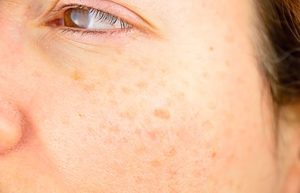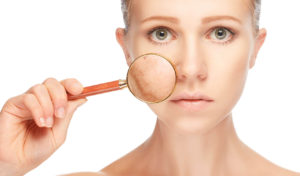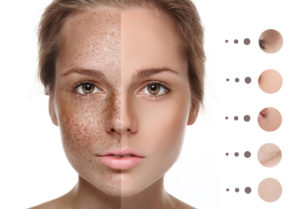Types of Pigmentation
Types of Pigmentation
How did I get this discolouration? Types of Pigmentation and what caused this?
What we know so far:
- Pigment is a term to describe colouring.
- Pigmentation is a term often used to describe discolouration seen on the skin; discolouration outside our natural colour.
- Pigment is a natural occurrence in humans. Over-production of pigment however is not and can be due to many factors, often complex in nature, ranging from UV damage or too much sun exposure, trauma/injury, chemical and hormonal influences.
- Pigmentation on the skin can occur suddenly or over a period of years, depending upon the cause and type of pigmentation seen.
- Science, research and technology is continually updating our understanding and knowledge when it comes to pigmentation. It is not static nor is the type, reason, cause or treatment.
Common Types of Hyperpigmentation:
UVA & UVB Damage
Age Spots / sun spots / damaged skin, most commonly caused by over exposure to the sun, this damage occurs over many years and is a sign of damage to the skin. This UV damage depletes the skin’s own natural resilience and can lead to not only areas of pigmentation but also redness, sensitivity, prematurely ageing skin, dull, lifeless skin and many other skin conditions.
Usually found on areas of the body frequently exposed to the sun such as the face, neck, décolleté, shoulders and hands – these spots are usually smallish in size. It was more common to see these in the over-forty age groups however this is no longer the case and can now be seen in younger age groups.
NB:
 UV spots, age spots, damaged skin can be benign or can be cancerous – it is vital to have a regular skin examination using the technique of dermoscopy by a trained/experienced professional.
UV spots, age spots, damaged skin can be benign or can be cancerous – it is vital to have a regular skin examination using the technique of dermoscopy by a trained/experienced professional.- It is important to point out that New Zealand has the highest world-wide incidence of melanoma (a type of skin cancer). Although melanoma can have a combination of causes it is believed that UV exposure is our greatest trigger and cause of this.
Hormonal
Triggered by hormones (including hormonal medications), causing dark patches to appear on the skin. These patches or areas appear despite the sun: fluctuations in certain hormones can cause unwanted pigmentation to develop. This is often called ‘melasma’which appears when the melanocytes (pigment producing cells) become hyperactive and produce too much pigment (hyperpigmentation) in certain areas of the skin.
The mechanism is similar to what causes brown age spots and freckles, but melasma patches tend to be larger. They can be greyish-brown to brown or darker in colour and typically appear as symmetric, blotchy, hyper-pigmented patches on the face – usually the forehead, chin, cheeks, upper lip and bridge of the nose.
While less common, melasma can appear on other parts of the body – especially those areas more prone to sun exposure like the neck and forearms and can also be seen on the abdomen. Many say their melasma worsens in the summer and improves in the winter.
The sun can trigger melasma as the hormonal changes may not appear or manifest until one is subjected to sun exposure. It means that even with application of an SPF to protect your skin; that protection isn’t enough to ward off the development of melasma. In saying that, SPF is still vital and must be applied daily.
Some women develop melasma in pregnancy due to an increase in hormones. This is often referred to as the mask of pregnancy. These areas are more defined and often are more solid in their appearance. While this condition may be common among pregnant women it is not limited to them. Melasma may also occur when starting or stopping the oral contraceptive (birth control pills) or when taking hormone replacement therapy.
Hormonal pigmentation can affect both men and women although it is more commonly seen in women and especially those with darker skin tones. Unlike age spots or other types of pigmentation, hormonal pigmentation can reside post-pregnancy or after stopping oral contraceptives or medication triggering the hormonal pigment response.
Post inflammatory Hyperpigmentation (PIH)
PIH is an increase of the deposition of melanin in the skin that occurs following inflammation in the skin where the skin is left darkened or discoloured ranging in colour from pink, red, brown to black. Typically triggered and seen after trauma/injury, active acne, rashes, insect bites, allergic reactions, chemicals, drugs, abrasion to the skin, aesthetic procedures/surgery where the skin has become inflamed. These areas remain discoloured and appear as flat spots of discolouration even after the area/wound has healed.
PIH can be seen in those who suffer from inflammatory skin conditions such as dermatitis, psoriasis.
Men and women are equally susceptible and all skin colours can suffer from PIH however it is more prevalent in in those individuals with darker tones of skin.
Ageing and Pigmentation
Skin changes as we age are related to many factors such as our genetics, environmental factors, our nutrition, our general health and wellbeing. The greatest influencer on our skin is the sun. Ageing is accelerated by the effects and exposure to UV radiation. The results of sun damage to our skin shows or presents often with a combination of conditions such as: pigmentation (sun spots, age spots), lines and wrinkles, laxity, redness, thin fragile skin, compromised skin, sensitive skin, dull/tired/devitalised looking skin – all signs of premature ageing.
As we age our skin history plays a role in the function and number of our melanocytes – these cells can be at different “stages” of the aging process. Melanocytes decrease in numbers over time. However, research is showing that the ones remaining can become increased in size and their distribution of pigment changes creating unwanted pigmentation in those over forty.
It has been said that the appearance of pigmentation or discolouration on the skin ages us more dramatically than actual lines and wrinkles.
Disease and Medication
Certain illnesses and some medications are known to cause hyperpigmentation such as some hormonal, autoimmune and gastrointestinal diseases, metabolic disorders and vitamin deficiences. It can also be triggered by certain medication such as chemotherapy drugs, antibiotics, anti malarials and anti seizure drugs.
Reasons or Causes of Pigmentation
Pigmentation has a complex set of causes ranging from too much sun exposure and hormonal influences to our genetic make-up which can combine to form uneven skin colour. Not limiting the causes to:
- UV exposure
- Trauma, Injury, Inflamation
- Medications
- Chemicals
- Hormonal changes
- Some skin or medical conditions
Treatment Modalities for Pigmentation:
The age old adage “Prevention is better than cure” – in retrospect it’s easy to say this, no matter our age it is vital that we start that process as soon as we can.
Pigmentation takes many years to develop. It is often not seen until our later years and in turn, is not an overnight fix. In fact it takes time and dedicati on to reduce the signs of pigmentation. It is prudent to be sure that you have the right person looking after your skin – one with the right experience and qualifications.
on to reduce the signs of pigmentation. It is prudent to be sure that you have the right person looking after your skin – one with the right experience and qualifications.
In our next Blog on Pigmentation we will be looking at the current treatments available to reduce the visible effects of pigmentation.
In the meantime if you aren’t already – ensure you are putting your SPF on every day, all seasons. If you are thinking you would like to address the pigment you are noticing on your skin, start the process with:
-
- A visit to your dermal nurse/therapist at skinmatters
- Have your pigment checked by a trained, experienced professional using a Dermatascope – Taupo has Molemap and GP’s offering this service
Should you wish to find out more about pigmentation or any concerns you may have in regard to your skin please do not hesitate to contact me @ skinmatters.
Email: [email protected] or Mobile: 027 222 6206.



